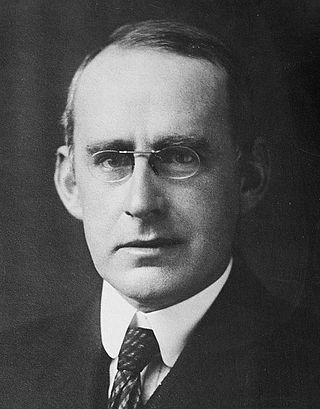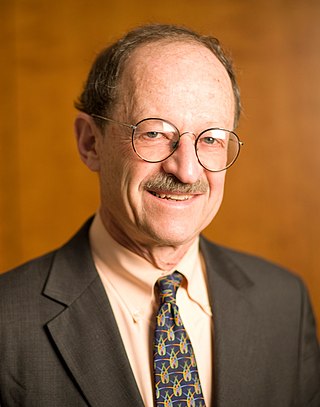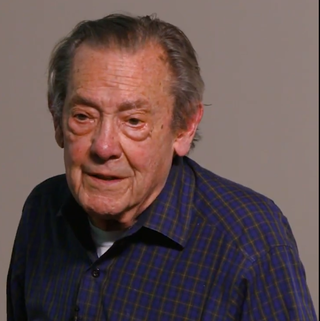Related Research Articles

The arrow of time, also called time's arrow, is the concept positing the "one-way direction" or "asymmetry" of time. It was developed in 1927 by the British astrophysicist Arthur Eddington, and is an unsolved general physics question. This direction, according to Eddington, could be determined by studying the organization of atoms, molecules, and bodies, and might be drawn upon a four-dimensional relativistic map of the world.

Harold Eliot Varmus is an American Nobel Prize-winning scientist. He is currently the Lewis Thomas University Professor of Medicine at Weill Cornell Medicine and a senior associate at the New York Genome Center.

John Michael Bishop is an American immunologist and microbiologist who shared the 1989 Nobel Prize in Physiology or Medicine with Harold E. Varmus and was co-winner of 1984 Alfred P. Sloan Prize. He serves as an active faculty member at the University of California, San Francisco (UCSF), where he also served as chancellor from 1998 to 2009.

Albert Claude was a Belgian-American cell biologist and medical doctor who shared the Nobel Prize in Physiology or Medicine in 1974 with Christian de Duve and George Emil Palade. His elementary education started in a comprehensive primary school at Longlier, his birthplace. He served in the British Intelligence Service during the First World War, and got imprisoned in concentration camps twice. In recognition of his service, he was granted enrolment at the University of Liège in Belgium to study medicine without any formal education required for the course. He earned his Doctor of Medicine degree in 1928. Devoted to medical research, he initially joined German institutes in Berlin. In 1929 he found an opportunity to join the Rockefeller Institute in New York. At Rockefeller University he made his most groundbreaking achievements in cell biology. In 1930 he developed the technique of cell fractionation, by which he discovered the agent of the Rous sarcoma, components of cell organelles such as mitochondrion, chloroplast, endoplasmic reticulum, Golgi apparatus, ribosome and lysosome. He was the first to employ the electron microscope in the field of biology. In 1945 he published the first detailed structure of cell. His collective works established the complex functional and structural properties of cells.

Randy Wayne Schekman is an American cell biologist at the University of California, Berkeley, former editor-in-chief of Proceedings of the National Academy of Sciences and former editor of Annual Review of Cell and Developmental Biology. In 2011, he was announced as the editor of eLife, a new high-profile open-access journal published by the Howard Hughes Medical Institute, the Max Planck Society and the Wellcome Trust launching in 2012. He was elected to the National Academy of Sciences in 1992. Schekman shared the 2013 Nobel Prize for Physiology or Medicine with James Rothman and Thomas C. Südhof for their ground-breaking work on cell membrane vesicle trafficking.
Bernd Heinrich, is a professor emeritus in the biology department at the University of Vermont and is the author of a number of books about nature writing and biology. Heinrich has made major contributions to the study of insect physiology and behavior, as well as bird behavior. In addition to many scientific publications, Heinrich has written over a dozen highly praised books, mostly related to his research examining the physiological, ecological and behavioral adaptations of animals and plants to their physical environments. He has also written books that include more of his personal reflections on nature. He is the son of Ichneumon expert Gerd Heinrich.

Ruth Sager was an American geneticist. Sager enjoyed two scientific careers. Her first was in the 1950s and 1960s when she pioneered the field of cytoplasmic genetics by discovering transmission of genetic traits through chloroplast DNA, the first known example of genetics not involving the cell nucleus. The academic community did not acknowledge the significance of her contribution until after the second wave of feminism in the 1970s. Her second career began in the early 1970s and was in cancer genetics; she proposed and investigated the roles of tumor suppressor genes.
David Burton Wake was an American herpetologist. He was professor of integrative biology and Director and curator of herpetology of the Museum of Vertebrate Zoology at the University of California, Berkeley. Wake is known for his work on the biology and evolution of salamanders as well as general issues of vertebrate evolutionary biology. He has served as president of the Society for the Study of Evolution, the American Society of Naturalists, and American Society of Zoologists. He was a member of the American Association for the Advancement of Science, the Linnean Society of London, the American Academy of Arts and Sciences, the American Philosophical Society, and in 1998 was elected into the National Academy of Sciences. He was awarded the 2006 Leidy Award from the Academy of Natural Sciences of Philadelphia.
Robert Elliot Pollack is an American biologist whose interests cross many academic lines. He grew up in Brooklyn, attended public schools, and majored in physics at Columbia University, where he graduated from the College in 1961. He received a PhD in Biological Sciences from Brandeis University in 1966, and subsequently was a postdoctoral Fellow in Pathology with Howard Green at NYU Medical center, and at the Weizmann Institute in Israel with Ernest Winocour. He was then recruited to Cold Spring Harbor Laboratory by James Watson to establish a research program on reversion of cancer cells. He became a tenured Associate Professor of Microbiology at the Stony Brook University Medical Center before returning to Columbia as a Professor of Biological Sciences in 1978. He served as Dean of Columbia College from 1982 to 1989, overseeing the enrollment of women in the College for the first time.
Marcel Florkin was a Belgian biochemist. Florkin was graduated as a Doctor in Medicine and became a professor of biochemistry at the University of Liège.

Edmund Slocum Crelin, Jr. Ph.D. D.Sc (1923–2004) was Professor of Anatomy at Yale University from 1968 to 1991.

Evelyn M. Anderson was an American physiologist and biochemist, most known for her co-discovery of adrenocorticotropic hormone in 1934.

Winslow Russell Briggs was an American plant biologist who introduced techniques from molecular biology to the field of plant biology. Briggs was an international leader in molecular biological research on plant sensing, in particular how plants respond to light for growth and development and the understanding of both red and blue-light photoreceptor systems in plants. His work has made substantial contributions to plant science, agriculture and ecology.
J. E. Hearst is an American-Austrian chemist in the fields of chemistry and molecular biology and a Professor Emeritus at University of California Berkeley. He is known for his scientific work in molecular biology, especially in DNA modeling. He has a high number of citations to his work (20,520) and an h-index of 74. He is also an author of a book on general chemistry.
The UCSF Graduate Division is the graduate school of the University of California, San Francisco, and is located in San Francisco. It is recognized as one of the premier biomedical graduate schools in the United States. It offers 19 PhD programs, 11 MS programs, two certificates and a physical therapy program.

Rosalind Wulzen was an American physiologist, known for her discovery of the "Anti-Stiffness Factor," or "Wulzen Factor." Born in Oakland, California, Wulzen attended the University of California Berkeley for her bachelor's, master's, and doctoral degrees.
References
- 1 2 3 4 5 "Obituary: Harold F. Blum (1899-1980)". Photochemistry and Photobiology. 33 (3): 287–288. 1981. doi:10.1111/j.1751-1097.1981.tb05419.x.
- ↑ "Foundation Report: 1936 - US & Canada Competition, Natural Sciences - Organismic Biology & Ecology: Harold F. Blum". John Simon Guggenheim Memorial Foundation. 1936. Archived from the original on 2015-02-21.
- ↑ Blum, Harold F. (1951). Time's Arrow and Evolution (First ed.). ISBN 9780691023540.
- ↑ Morowitz, Harold J. (September 1969). "Book review: Time's arrow and evolution: Third Edition". Icarus. 11 (2): 278–279. Bibcode:1969Icar...11..278M. doi:10.1016/0019-1035(69)90059-1. PMC 2599115 .
- ↑ McN., W. P. (November 1951). "Book reviews: Time's Arrow and Evolution". Yale Journal of Biology and Medicine . 24 (2): 164. PMC 2599115 .
- ↑ Scholes, Robert; Rabkin, Eric S. (1977). "Bibliography III: Science Backgrounds". Science Fiction: History, Science, Vision. London: Oxford University Press.